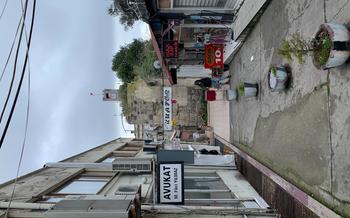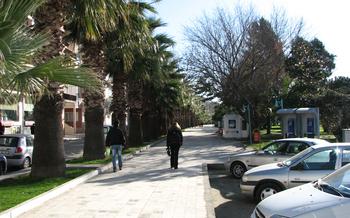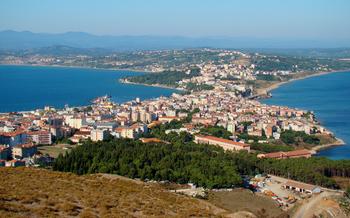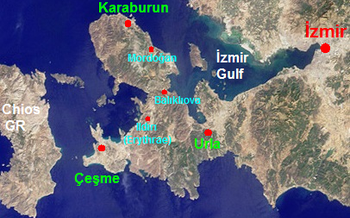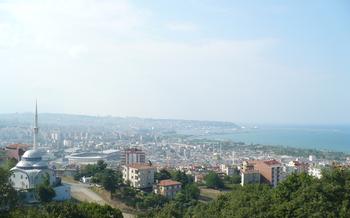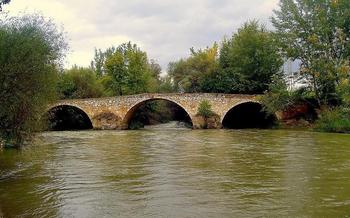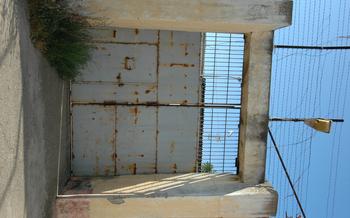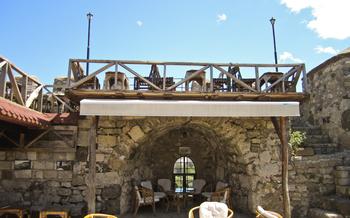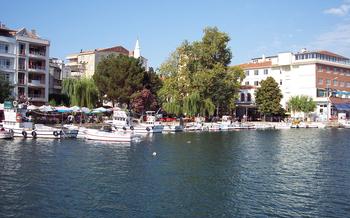
Sinop Ethnography Museum
- Historical Background
- Location and Accessibility
- Museum Highlights
- Thematic Exhibitions
- Artifacts and Collections
- Historical Context
- Educational Programs
- Architectural Features
- Interactive Displays
- Local Crafts and Handicrafts
- Temporary Exhibitions
- Museum Shop
- Accessibility
- Insider Tip: Unveiling Hidden Treasures and Capturing the Essence of Sinop Ethnography Museum
Historical Background
Sinop, a city steeped in history, has been inhabited since the 7th century BC and has served as a significant port and trade center throughout the ages. The Sinop Ethnography Museum plays a pivotal role in preserving and showcasing the rich cultural heritage of this ancient city. It houses a diverse collection of artifacts, documents, and exhibits that narrate the captivating story of Sinop's past, providing visitors with a glimpse into the lives, customs, and traditions of its people across different eras. The museum serves as a valuable resource for researchers, historians, and culture enthusiasts seeking to delve deeper into the historical tapestry of this remarkable city.
Location and Accessibility
The Sinop Ethnography Museum is situated in the heart of the city of Sinop, Turkey, at Kurtuluş Mahallesi, Atatürk Caddesi No:82. It occupies a prominent location within the city center, making it easily accessible to visitors.
Reaching the museum is a breeze, whether you choose to explore the city on foot or utilize public transportation. For those who prefer to stroll through the charming streets of Sinop, the museum is just a pleasant walk away from many popular tourist attractions.
Alternatively, several public transportation options are available for those seeking a more convenient journey. The museum is well-connected by local buses, with designated stops within walking distance. Visitors can also opt for the taxi services readily available in the city.
Upon arrival at the museum, ample parking space is available, ensuring a hassle-free experience for those traveling by car. The museum's central location and accessible parking make it a convenient destination for visitors to delve into the rich cultural heritage of Sinop.
Museum Highlights
The Sinop Ethnography Museum is a treasure trove of unique artifacts and exhibits that shed light on the rich cultural heritage of the region. Among the highlights of the museum's collection are traditional costumes and textiles, intricate pottery and ceramics, and a fascinating display of agricultural tools and equipment. These artifacts provide a glimpse into the daily lives and customs of the people who have inhabited this land for centuries.
The museum also boasts a collection of historical documents and manuscripts that offer valuable insights into the region's past. These documents include official decrees, religious texts, and personal letters that provide a glimpse into the political, social, and cultural dynamics of Sinop throughout history.
For those interested in interactive experiences, the museum features several multimedia displays that bring the exhibits to life. These displays use touch screens, videos, and interactive games to engage visitors and provide a deeper understanding of the region's history and culture.
Thematic Exhibitions
The Sinop Ethnography Museum hosts various thematic exhibitions that delve into different aspects of local history and culture. These exhibitions offer visitors an opportunity to explore specific themes in greater depth and gain a deeper understanding of the region's heritage. Some of the themes explored in previous exhibitions include:
- Maritime History of Sinop: Highlighting the city's rich maritime history, this exhibition showcased artifacts and documents related to shipbuilding, navigation, and trade.
- Traditional Crafts and Handicrafts: This exhibition celebrated the diverse craftsmanship of the region, featuring handmade textiles, pottery, jewelry, and woodwork.
- Rural Life in Sinop: Visitors could learn about traditional farming practices, agricultural tools, and the daily life of rural communities in Sinop through this exhibition.
- Sinop in the Ottoman Era: This exhibition explored the city's transformation during the Ottoman period, showcasing artifacts and documents that shed light on its administrative, economic, and cultural developments.
The museum's thematic exhibitions are often temporary, allowing for a dynamic and ever-changing display of the region's heritage. Visitors are encouraged to check the museum's website or inquire at the information desk for details on current and upcoming exhibitions.
Artifacts and Collections
The Sinop Ethnography Museum houses a diverse array of artifacts that provide a fascinating glimpse into the region's rich cultural heritage. These artifacts encompass a wide range of categories, including traditional textiles, intricately painted pottery, and tools that showcase the ingenuity and craftsmanship of past generations.
Among the notable collections in the museum are the exquisite handwoven carpets and kilims, which are renowned for their vibrant colors and intricate patterns. These textiles offer a testament to the skill and artistry of local weavers, who have preserved this centuries-old tradition. The museum also boasts an impressive collection of pottery, featuring a variety of styles and techniques that reflect the diverse influences that have shaped the region's history.
One of the most captivating artifacts in the museum is a beautifully preserved wooden plow, a poignant reminder of the region's agricultural heritage. This humble tool, once essential for tilling the land, speaks volumes about the hard work and dedication of the local farmers who have sustained the region for generations.
Each artifact in the Sinop Ethnography Museum carries a unique story, waiting to be discovered by visitors. These objects serve as tangible links to the past, offering insights into the lives, customs, and traditions of the people who have called this region home.
Historical Context
The Sinop Ethnography Museum offers a profound journey through the historical tapestry of Sinop and its surrounding region. Each exhibit is meticulously arranged to narrate the captivating story of past civilizations that once flourished on these lands. Visitors are taken on a chronological voyage, beginning with the earliest settlements and culminating in the vibrant culture that defines Sinop today.
Displayed artifacts provide tangible evidence of the region's rich past. Tools, pottery, and ancient texts offer glimpses into the daily lives and customs of bygone eras. Elaborate jewelry and ornate garments speak to the artistry and craftsmanship of past generations. Through these objects, visitors gain a deep appreciation for the continuity and evolution of human civilization in this enchanting corner of the world.
The museum also sheds light on significant historical events that shaped the region's destiny. From the rise and fall of empires to the impact of trade and migration, each exhibit is carefully curated to provide context and understanding. Visitors leave with a comprehensive grasp of the historical forces that have influenced the unique identity of Sinop.
Educational Programs
The Sinop Ethnography Museum offers a variety of educational programs to enhance the visitor experience and promote learning. Guided tours are available for groups and individuals, led by knowledgeable docents who provide insights into the museum's collection and the history and culture of Sinop. These tours offer a deeper understanding of the exhibits and allow visitors to ask questions and engage in discussions.
In addition to guided tours, the museum also organizes workshops and lectures related to its exhibits. These events provide opportunities for visitors to learn from experts in various fields, such as history, archaeology, and ethnography. Workshops often focus on hands-on activities, such as traditional crafts or cooking demonstrations, allowing participants to experience Turkish culture firsthand.
For students and researchers, the museum offers educational resources such as a library, archives, and databases. These resources provide access to a wealth of information on the region's history, culture, and ethnography, supporting research projects and academic endeavors. The museum's educational programs are designed to cater to a wide range of audiences, from casual visitors to students and researchers, fostering a deeper understanding of Sinop's rich heritage and cultural traditions.
Architectural Features
The Sinop Ethnography Museum is housed in a striking building that is a testament to the region's rich history and architectural heritage. The building, which dates back to the 19th century, was originally constructed as a prison. Over the years, it has undergone several renovations and expansions, resulting in a unique blend of architectural styles.
The museum's exterior showcases a blend of Ottoman and Neoclassical elements. The imposing stone façade is adorned with intricate carvings and decorative moldings. The arched windows and doorways add a touch of elegance to the building's overall appearance.
Inside, the museum's spacious galleries feature high ceilings and polished wooden floors. The walls are adorned with intricate tilework and frescoes, depicting scenes from Turkish history and mythology. The museum's layout allows for a seamless flow of visitors through the different exhibits.
The museum's architecture not only serves an aesthetic purpose but also enhances the visitor experience. The spacious galleries provide ample room for displaying the museum's extensive collection of artifacts. The natural light that floods in through the large windows illuminates the exhibits, creating a warm and inviting atmosphere.
The Sinop Ethnography Museum's architectural features are a testament to the region's rich history and cultural heritage. The building's unique blend of architectural styles and its thoughtful layout create a memorable and immersive experience for visitors.
Interactive Displays
The Sinop Ethnography Museum features a range of interactive displays that enhance the visitor experience and make learning about local history and culture more engaging. These interactive exhibits employ technology and hands-on activities to provide a deeper understanding of the region's heritage.
One interactive highlight is a digital timeline that allows visitors to explore the history of Sinop from its ancient origins to the present day. By touching the screen, visitors can access information about key events, historical figures, and cultural developments that have shaped the region.
The museum also has a replica of a traditional Sinop house, where visitors can step inside and experience the daily life of a local family. Interactive elements within the house allow visitors to learn about traditional customs, household chores, and the use of various tools and utensils.
Another interactive exhibit showcases local crafts and handicrafts. Visitors can try their hand at weaving, pottery, or other traditional crafts, gaining an appreciation for the skills and techniques passed down through generations.
These interactive displays not only make the museum more engaging for visitors of all ages but also provide a deeper understanding of the region's history, culture, and traditions.
Local Crafts and Handicrafts
The Sinop Ethnography Museum also showcases the rich tradition of local crafts and handicrafts. Visitors can admire intricate carpets, colorful embroideries, hand-woven textiles, and finely crafted pottery. These exhibits provide insight into the skills and artistry of local artisans and highlight the cultural significance of these crafts in the region.
The museum's collection includes a variety of traditional crafts, each with its distinct style and techniques. Visitors can learn about the processes involved in creating these handcrafted items, from the selection of raw materials to the intricate finishing touches. The museum also hosts workshops and demonstrations, allowing visitors to engage with local artisans and gain hands-on experience in creating their own crafts.
By supporting the preservation and promotion of local crafts, the Sinop Ethnography Museum plays a crucial role in sustaining the cultural heritage of the region. Visitors can contribute to this effort by purchasing souvenirs and handicrafts from the museum shop. These purchases directly support local artisans and help ensure the continuation of these traditional practices for generations to come.
Temporary Exhibitions
The Sinop Ethnography Museum hosts temporary exhibitions alongside its permanent collection to provide visitors with a diverse and ever-changing experience. These exhibitions delve into specific themes or topics related to the region's history, culture, or traditions. Temporary exhibitions often feature artifacts and objects that are not part of the permanent collection, offering visitors a unique opportunity to explore different aspects of Sinop's heritage.
The museum collaborates with local artists, historians, and cultural organizations to curate these temporary exhibitions. This approach ensures that the museum's offerings remain fresh and relevant to contemporary interests and research. Temporary exhibitions also contribute to the museum's mission of promoting cultural understanding and appreciation by showcasing the diverse aspects of Sinop's rich history and traditions.
Visitors to the Sinop Ethnography Museum are encouraged to check the museum's website or social media pages for information on upcoming temporary exhibitions. These exhibitions often include special events, workshops, or lectures related to the featured theme, providing visitors with an immersive and interactive experience.
Museum Shop
The Sinop Ethnography Museum boasts a well-curated museum shop that offers a diverse selection of souvenirs and locally crafted products. From traditional Turkish handicrafts to replicas of artifacts displayed in the museum, visitors can find a unique memento of their visit.
The shop supports local artisans and businesses by showcasing their work and providing a platform for them to sell their products. Visitors can find a variety of handmade items, including intricate ceramics, woven textiles, and delicate jewelry. These items not only represent the region's rich cultural heritage but also provide a sustainable source of income for local craftspeople.
By making a purchase at the museum shop, visitors can not only take home a piece of Sinop's history and culture but also contribute to the preservation and promotion of traditional crafts. The revenue generated from the shop helps support the museum's educational programs, exhibitions, and conservation efforts.
So, whether you are looking for a meaningful souvenir, a unique gift, or a way to support local artisans, be sure to visit the museum shop at the Sinop Ethnography Museum.
Accessibility
The Sinop Ethnography Museum is committed to providing an accessible and inclusive experience for all visitors. Wheelchair accessibility is ensured throughout the museum, with ramps and elevators available to navigate different levels of the building. Visitors with disabilities can also request assistance from the museum staff, who are trained to provide support and guidance. The museum's website offers detailed information about accessibility features, including designated parking spaces and accessible restrooms, making it easy for visitors to plan their visit accordingly. By prioritizing accessibility, the Sinop Ethnography Museum strives to create a welcoming and inclusive environment for everyone to explore and learn about the rich cultural heritage of Sinop.
Insider Tip: Unveiling Hidden Treasures and Capturing the Essence of Sinop Ethnography Museum
Unveiling Hidden Treasures: Beyond the main exhibition halls, the Sinop Ethnography Museum holds secret treasures waiting to be discovered. Venture into the museum's hidden corners and uncover unique artifacts, forgotten stories, and intriguing exhibits that shed light on Sinop's rich past. Keep an eye out for special displays tucked away in nooks and crannies, showcasing rare objects or providing deeper insights into the region's cultural heritage.
Recommended Time to Visit: To immerse yourself in the museum's tranquil ambiance and avoid the hustle and bustle of crowds, plan your visit for a weekday morning. This allows you toじっくりとexplore the exhibits without distractions, engage in meaningful conversations with the museum staff, and fully appreciate the serenity of the museum's surroundings.
Tips for Capturing Great Photos and Experiences: Capture the essence of your museum visit through stunning photographs. Take advantage of the natural light streaming through the windows to illuminate the exhibits. Experiment with different angles and perspectives to create unique compositions. Don't forget to engage all your senses during your visit. Take a moment to sit down and observe the intricate details of the artifacts, listen to the stories they whisper, and let the atmosphere transport you back in time.
